
home
methodology
& outputs
© University of Newcastle upon Tyne
 Second order water scarcity in Southern Africa
Second order water scarcity in Southern Africa
The DFID Engineering KaR Programme: Proposal W1-17, 2002-2007
A Second Specimen Interview
Interviewee: Staff of Water and Sewerage Department, Mansa Municipal Council
Venue: MMC offices, Mansa on 1st July 2004
[ a full version of this interview is available also as an Acrobat file, 112kb ]
What is the domestic water supply situation here in Mansa?
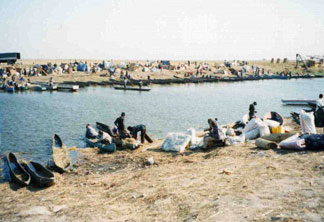
Actually at the moment we are only dealing with a small group of residents. We are only on high cost, medium cost and low cost houses. Even commercial and government departments and we are giving water to institutions like schools and colleges. Our water supply point is actually Mansa River and we are pumping at least 10 hours per day. We are supposed to pump 12 hours per day but we have only one pump running. This gives the pump 2 hours of rest. We know that if we pump more than 10 hours say the full 12 hours it means the pump can break down any time. We are trying to pump at least É the pumping capacity of our machine is at least 80 litres per second which is the raw water pump. Then pumping to our slow sand filter we have got 4 slow sand filters of which we always operate 3 and one remains for cleaning. So as it is now we clean nearly every week, so each one gets cleaned once a month. The main problem we have with our slow sand filters is that they are old. They have lasted for almost ten years with the same batch of sand. We are supposed to remove the sand every five years and bring in a new batch. At the moment our sand is choked that is why we are cleaning every month to make it possible to purify better. Then we have got some areas where they are not receiving water, like Senema.
Where exactly is Senama?
Senama is on Samfya road near Mtende Site and Service. That area, there are about 300 and something houses. We have plans this year to secure some pipes so that we can extend to Mtende Site and Service where people are still using dug out wells. The other area is partly Spark. There the other area is receiving water while the other one is not but we are still working on it. Then on, we have got some villages surrounding us like Sungu, Kapesha those there is no extension though the plans are there to extend that service to Kapesha and Sungu. On the payments we have a very big problem although we have got at least, on the residential we have 3060 and the active payments only go to 100 to 105. On commercial we have 150 only 80 of these are active. On the government offices some offices have started paying us now. Previously they were saying we were not pumping enough to justify their payments but of late they have seen that there is change in our operations and they have started paying. At that time we were getting 5 million per month then this time it has been increased to 27 million. Expenses are high than the income but if they are paying every month the scheme is viable and it can expand on its own.
How much do your expenses exceed your revenue or income by?
On electricity itself is K5 million then even chemicals, pipes, it goes to above K15 million.
You said there has been an improvement in the service provision since February. Do you have specific reason for this improvement?
We had, the town clerk had, separated departments. Previously we were all under the engineering department but now water was separated to be headed by a separate person and concentrate on water issues. Rather than working on other roles like buildings. That is why at the moment we are only concentrating on water. Previously we were only pumping about 4 hours per day and now we have increased to 10 hours per day.
So the government departments are now agreeing to pay for water as there is water in their offices for the duration of their stay there or through out working hours?
Yes except we are worried as it happened on Sunday, the electricity went off. At the water plant we do not have a generator so that we can have power in such cases. We only rely on the national grid so like on Sunday it went off on Saturday and came back on Sunday.
So for the whole of Saturday there was no water?
No there was no water until the power was restored. Our friends are saying the water in the Musonda scheme is very low.
The Musonda scheme is used to supply power to Mansa?
Yes so going back to the national grid where we are right at the end. It would appear that we will have very little power or power shortages later in the year.
Do you by any chance know why the level in the Musonda scheme is low?
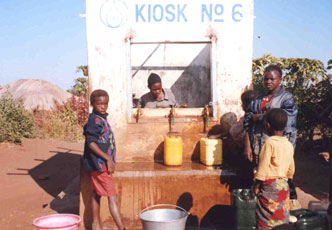
It is always low in the range of July to September.
Even in the years when we have excess rainfall is the water in the Musonda scheme low?
Well I can compare it to 1998 when we had very good rain fall then we didn't have any problem. There are some years like last year when the rainfall was quite low then we had some problems.
Looking at the people who actively pay their bills, are they all on a fixed charge?
Yes we have on the high cost K15000 then medium cost is K10000. No high cost is K20000, and then medium is K15000 and low cost is K10000. On the commercial side we some paying K150000, then some K200000 and some K300000. Those are our charges.
Do these charges include paying for the sewerage or is this solely water?
This is just water no sewage charge is included. On sewerage here in Mansa moreover the houses in high cost and medium cost they are only using septic tanks and soak aways. Few of the low cost houses use drainage pipes for their sewerage.
Is it right to assume that septic tanks and soak aways work well in low density populated areas?
No it depends on the capacity of the tank or the soak away and the manner in which it is used. To dig the soak away there is a formula that is used depending on the number of children the family has and the total number of people in the household. That is the formula used to determine the length of the soak away or the septic tank.
Does your department deal with rural water supply or is the rural section dealt with by Water Affairs?
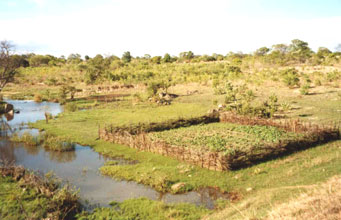
At the moment the rural water supply is still done by WASHE where I am also a member. At the moment these funded projects in water and sanitation we only advise or give technical advice to the communities. They have formed their own VWASHEs within their areas so as a DWASHE we only supervise and monitor and coordinate.
Some members of the general public feel the water supply from your department is very erratic and so they dig wells in order to have a constant supply of water. What is your response to this?
As I have said there are some areas that have no water supply but there are also areas like high cost and medium cost where even at night we supply them with water.
I thought you only pump for 10 hours a day?
Yes, 10 hours per day. This means out of the 12 hours we pump for 10 hours. So then at night we pump for another 10 hours out of 12.
Oh so you pump for 20 hours in full 24 hour day?
Yes, though there are some areas in low cost that actually receive more than the high cost areas. Like for example section, A, B, D, and M they receive more water than the high cost areas. The only problem at times with us is that there is no electricity. If it wasn't for the power failures we try to pump at least 20 hours out of 24 hours.
You mentioned that these increases in pumping hours and revenue collection came in after February when your department was separated from engineering. Since February has there been any change in the allocation of funds for the water department? Or are the revenues from water reinvested in the water department?
We have to pump back some of the K 27 million revenue into the water infrastructure. For the past 2 months we have experienced a lot of bursting of pipes because of the increased supply. We are using the same money to buy pipes if a burst occurs.
The increase of revenues and pumping hours has been a result of change of management and operations in the department. The increase in revenue is at least 5 fold or 500%. I believe this is the type of improvement being aimed at in the formation of the commercial utility. Are you in the process of forming a commercial utility here and do you think it is necessary?
No this is a way forward to meet the commercial utility concept. First of all you need to have your own resources as a department and manage yourself, see where you want to increase and see to it that you put down what it is you want to do. Out of that plan is where you go into the legal issues for forming a utility company.
Would the commercial utility here be only for Mansa or cover the whole province?
On that we went through that with one of the consultants. Which came up if we did combine with other council it would be very expensive for Mansa to have resources which other districts would most likely rely on the provincial headquarters. So the best option is to be on our own. The commercial utility would only be for Mansa and the others would then combine. The other option was to combine with a nearby district not the far off ones. This is in terms of supervision considerations which would be difficult to do for far off places.
In other areas before clients agree to pay for a service, they would like to see an improvement in their services. Has this been the trend here?
There are two ways of getting people to pay for a service; you have to build up a system. Nobody is willing to pay if there is no system. So first you give them the services then bill them. If they don't pay then you threaten to go to court or you tell them that we are going to shut down the water or cut the supply. That was the system we started with. We improved the service and then gave people a warning and they started paying. We gave them about 3 months and if they didn't pay then we disconnected the supply.
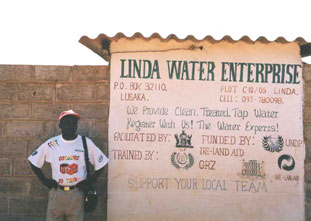
What did it actually take for you to improve the service?
Well the plant itself, or even ourselves when we were working, we didn't consider how many litres we were going to pump per day. We were just pumping without knowing the consumption like how many litres a person can use a day. When we went into the actual consumption at that time we were only pumping 4 hours per day which meant that most of our customers were not receiving water. So we went to check, why we are not pumping enough water for all our clients. We found that 3 sand filters were choked and were working on each sand filter once every 3 months. We came to a decision that we have to clean our sand filters once a month to increase the water output. When we did that we found that there was a step increase from 4 to 10 pumping hours per day. The other thing is we went into servicing of pumps. Last year we only had 1 raw water pump with no stand pipe. So we are trying to find some spare parts to fix the pump and have one on standby even though this one will be running at a very low pace like 20 litres per second as compared to the 80 litres per second but we do need a stand by pump.
Before February you had 4 hours of supply. How long had you pumping been at 4 hours a day?
It was in 2002. This is when the main problems seem to have started. We didn't have the routine cleaning of filters and the servicing of pumps. So gradually the pumping hours reduced to 4.
What are your views on the National Water Policy and the impact on your business operations?
You know what, a policy is a policy. The water reforms have come so we have to accept it, though in a way the policy has its own problems. The government didn't pump anything into the schemes. What the wanted was the Local Authorities to renew the licences costing about K4 million a year. The formulation of the policy is good but now it needs to be backed. The one thing I like is that there is technical advice given when we meet people like the ones from NWASCO and other CUs.
What are you views on the issues of cost recovery and self sustaining water departments?
You see these things were supposed to have started a long time ago, if we knew then or if water had its own administration or if there is potential to grow. Now as it was the water departments were pumping money in to the councils. This money was not pumped back into the schemes at all. So you find that you don't maintain pumps. No other maintenance like sand replacement is done as money is not pumped into the scheme because the money is put in the coffers of the council and used else where in other departments.
I understand that the council has very little income sources. I think at the moment it is only the land rates, licences and markets plus the bus stations that are a revenue source so is it not likely that the water revenue will be diverted to other departments?
You are right in saying that the income for the council is limited and not enough to support all the staff and council activities. We have agreed to put a certain percentage into the council coffers and have a certain percentage remain to be ploughed back into the water department for maintenance and operation costs.
What are the main challenges that you face when trying to provide a high standard of service?
You see the main issue currently is the ZESCO power cuts that I mentioned. If ZESCO can give us a consistent supply then we would be able to provide a better service. The other thing is we have tried to talk to MLGH over the acquisition of a raw water pump. At the moment the ones we are using can break down any time. We have been using these for the last 6 years that I have been here. We also wanted to repair one tank, if you go along Chembe road there is a metal tank there that is leaking and needs repair. We hope to use two tanks and also hope in the future to negotiate with Mansa trades. They have an iron reservoir which is not working. We wanted to rehabilitate that and store water for Mansa Teachers residences, the Mutaba area and the newly created Imokola are We also wanted to go to Spark, buy a small reservoir and start pumping water in reservoirs there so we have at least 6 storage areas because at the moment we have only 1 elevated tank working. Although we pump water and the tank gets full the rest of the water gets wasted so we need more storage places. These are the plans we have made.
Have you been working in Mansa for 6 years or in the water sector for 6 years?
I have been working in the water sector for 6 years.
In the 6 years you have been here, going back to the water reforms, what other changes would you like to see at institutional level that would improve your operations?
You know we are now trying to have specific officers that will be dealing with water. We have departmental structure with vacancies that need to be filled in the management of the department. We also need transport as at the moment we only have one vehicle. We also would like to have a Honda to distribute bills and read meters. Some people say they do not get bills. We do have two people that are in the filed and getting complaints and the likes. We are also working on a data base to capture those that say they do not get water or a water bill. We are remaining with about 5 %. So you find that at the end of the month we have an increase in revenue.
If you want to rehabilitate your water works or replace sand filters, you will require capital expenditure. Are you in a position as a department to acquire loans or apply for external funding seeing as once you generate more income you will be able to pay off the loan?
At the moment we only rely on the ministry, on DISS. When we apply to the Ministry, the request is presented to DISS. If they have some resources then they give us either in the form of chemicals or they contract out like they did last year, we had a problem of pipes. We requested DISS and they contracted someone from Lusaka to bring in the pipes that could only be sourced from Kitwe. The pipes were sourced and the payment was made from Lusak What we want is the job to be done.
Have there been any water quality tests been done on the raw water?
Yes we had one inspector who was coming every Monday to collect water samples from the water supply. We are looking at the results from those tests. The results were all not bad.
When you speak of the chemicals are you talking about the aluminium sulphate and chlorine that is used else where?
Yes we also use the same chemicals.
Now you actually procure these yourself and not through the Ministry?
We started last month, we got some from MLGH, we were given about 100 drums so when this run out we bought about 4 drums last month.
Did you request the 100 drums or is it an annual allocation?
No we request because when we went there in February we were told that the Ministry is short of HTH chlorine so we were asked to buy it ourselves. We sourced the money and bought the drums.
Does the Ministry reimburse the money you spent?
No it is for the supply.
My question is more that is the MLGH obligated to supply the chemicals or do they only provide them when they can?
What it is that there is a scheme in the Ministry where if they are buying chlorine you have to pay something there. When they get the stock the Ministry has to send circulars that the chlorine is in stock so please come and buy from here and not from private suppliers. The private companies are usually very expensive so with the ministry we buy at a reduced price. At the moment we have gone back to ordinary shops being our suppliers.
is the scheme only open to the LAs that are still running their water schemes or even the CUs?
The CUs actually use chlorine cylinders so they do not need the HTH chlorine. They buy the cylinders themselves. I am sure you have seen some of the cylinders at Lusaka International Airport.
When you talk about bringing your revenues up to the same level as your costs, do you see a possibility of increasing your water rates?
The increase of rates is not a solution for us. The solution is to increase the water supply to areas where they do not get water and the moment.
Will that make revenues exceed the cost of operation and service provision?
Yes for example if we give Mtende SS where there are 300 houses and we multiply by 20000 that is almost 6 million. If also give the commercial entities building along Chembe road say about 20 commercial houses. That means another 6 million if they pay K300000. In the same month we would have more effect than increasing the rates as some people will stop paying. So it will come to the same. The best way I know is to expand.
Do you charge a reconnection fee after disconnection of services?
Yes for residential clients the reconnection fee is K50, 000 and for commercial clients it is K 200, 000.
Do you find illegal connections and if so how do you deal with them?
What we normally do if we disconnect and find a reconnection without authorization the punishment is to increase your bill and give you 7 days to pay the bill and reconnection fee. If no payment is made then we take the case to court.
Are clients who can afford the service and make a request expected to buy their own in outs like pipes before a connection is made?
The client can either buy their own pipes or we buy the pipes and charge the customer for the purchase. The methods are mutually exclusive.
Do you have any other comments?
You have touched on all areas apart from one. Is our water source reliable in the long term?
Actually that is because I was handed the report submitted by the team of consultants which looked at the viability of Mansa River.
It did happen once in 1978, the water level was low and the river was almost dry. Here in Mansa we were using tankers for our water supply until the rains came again. Now at the moment the rainfall seems to be adequate. If we find that the water is becoming low, we have made a temporary arrangement with a weir so we can use that to store water.
Actually you have reminded me of one another thing. In Chipata there are water kiosks used in the peri-urban areas. Do you have any kiosks here or have plans to install some?
No, the consultants did mention something about the kiosks. You will read about the decision there.
I know in some places the water from wells is not very bad especially in the low density populated areas. Do you have the option to maybe dig protected wells in the peri-urban areas?
Here in Mansa the situation is rather different from other places it is quite funny. You can drill a borehole or dig a well and it will dry up.
Oh really and why is that?
We have two boreholes and the yield is very bad even if you dig deep, very deep, the yield is bad about 5 litres per second.
Is the water table very low?
Yes the water table is low but the place is also very rocky.
Could that be the reason why NGOs are not very active in this area like in terms of drilling boreholes and the like?
Well that is true, here we have lots of rock up to 6 km.
I hear now JICA is coming to drill some boreholes will the situation not be the same in terms of low yields?
No they are looking at rural water. In the outskirts the rocky places are not as common. Only this place here in Mansa central is very rocky.
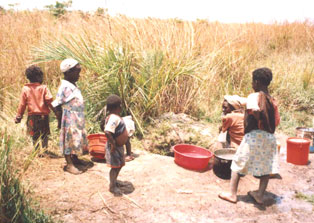
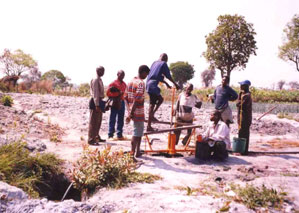
Emerging Themes: